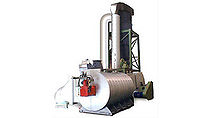Difference between revisions of "Closed Loop Dryers"
(Created page with "Category:Drying{{Knoppen}} <noinclude><!------------------------------------------------ * READ THIS FIRST * Only edit this page if you can improve the content. * Improper u...") |
|||
| (One intermediate revision by one other user not shown) | |||
| Line 7: | Line 7: | ||
* Please start editing this page after the /noinclude | * Please start editing this page after the /noinclude | ||
* -------------------------------------------------></noinclude> | * -------------------------------------------------></noinclude> | ||
[[File:Closed_Loop_Dryers.jpg|thumb|200px|right|Closed Loop Dryers]] | |||
The '''Closed Loop Dryers''' designed as a closed system in which heated air used to dry the materials is continuously recycled within the drying compartment of the dryer without being discharged to the atmosphere, thus increasing the efficiency of the system while preventing the discharge of contaminated vapors to the atmosphere and also conserving energy which would otherwise be required to heat or air-condition the air drawn into the dryer from the building in which the dryer is located. | |||
==Working Principle== | |||
A regenerative [[Heat Exchangers|heat exchanger]] and an atmospheric [[Coolers|cooler]]/condenser are provided in the dryer and condense and remove moisture from the saturated air and transfer the heat of condensation back into the air before the air is reheated and recycled back to the materials to be dried. The drying compartment may comprise an enclosed tunnel through which a rack of superposed trays are conveyed or may comprise some other conveying mechanism. | |||
==Aplications== | |||
The Closed Loop Dryer employs a proven [[Flash Dryers|flash drying technology]] for tobacco. The closed loop drying and expansion system is a fully automatic process, which produces substantial increases in whole blend or stem expansion over conventional methods of tobacco processing. The use of low pressure superheated steam allows very fast, continuous processing. The key features of the Closed Loop Dryer are improved expansion combined with low degradation, resulting in significant reduction in “loose ends”. The process ensures gentle and uniform handling of tobacco particles, which leads to stable product moisture control. | |||
Latest revision as of 21:19, 19 August 2012
The Closed Loop Dryers designed as a closed system in which heated air used to dry the materials is continuously recycled within the drying compartment of the dryer without being discharged to the atmosphere, thus increasing the efficiency of the system while preventing the discharge of contaminated vapors to the atmosphere and also conserving energy which would otherwise be required to heat or air-condition the air drawn into the dryer from the building in which the dryer is located.
Working Principle
A regenerative heat exchanger and an atmospheric cooler/condenser are provided in the dryer and condense and remove moisture from the saturated air and transfer the heat of condensation back into the air before the air is reheated and recycled back to the materials to be dried. The drying compartment may comprise an enclosed tunnel through which a rack of superposed trays are conveyed or may comprise some other conveying mechanism.
Aplications
The Closed Loop Dryer employs a proven flash drying technology for tobacco. The closed loop drying and expansion system is a fully automatic process, which produces substantial increases in whole blend or stem expansion over conventional methods of tobacco processing. The use of low pressure superheated steam allows very fast, continuous processing. The key features of the Closed Loop Dryer are improved expansion combined with low degradation, resulting in significant reduction in “loose ends”. The process ensures gentle and uniform handling of tobacco particles, which leads to stable product moisture control.
